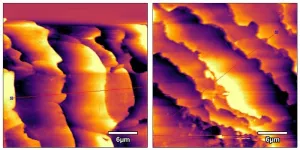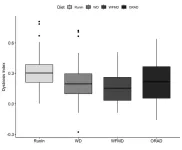(Press-News.org) INDIANAPOLIS, March 26, 2023 — Black women and others with curly or kinky hair encounter a vast and confusing array of haircare options. Advice on the best products to use for a certain type of hair is often contradictory, and the results can be highly variable. Now, scientists are bringing order to this chaos by identifying properties such as the number of curls or coils in a given length of hair that could eventually help users pick the perfect product and achieve consistent results.
The researchers will present their findings today at the spring meeting of the American Chemical Society (ACS). ACS Spring 2023 is a hybrid meeting being held virtually and in-person March 26–30, and features more than 10,000 presentations on a wide range of science topics.
“As an African American, I was born with very curly, seemingly unmanageable hair, and other ethnicities can possess similar hair properties,” says Michelle Gaines, Ph.D., the project’s principal investigator. Gaines used to rely on chemical relaxers to straighten her tresses but stopped when she became pregnant. She was then confronted with an overwhelming variety of products available to style and care for natural hair. Limited guidance about the best options for her particular hair type, and conflicting advice from friends, YouTube videos and other resources, didn’t help the situation.
Clearly, Gaines says, there is a major knowledge gap that needs to be closed, so she has set out to fill it. “As a polymer chemist and materials scientist, I thought it would be great to start a project where I could study the nuances of my hair, because I felt like it wasn’t very well understood,” she says.
Most prior research on properties was done on wavy or straight strands from white or Asian people, according to Gaines, who is at Spelman College, a historically Black college for women. Less is known about what has traditionally been called “African” hair, she says, though researchers at Groote Schuur Hospital and the University of Cape Town in South Africa have published some findings.
L’Oréal, as well as celebrity hair stylist Andre Walker and others, have developed systems to classify different types of hair. Walker’s system ranges from straight to kinky, a category including tight coils and zig-zag strands with angular bends. Although some people believe all of these classification methods convey a preference for a smoother and straighter appearance — a bias with historic links to the preferential treatment of enslaved people who had straighter hair and lighter skin — they’re intended to help users choose the most suitable haircare products. Gaines felt these systems worked well for straight and wavy hair but lacked the nuance to distinguish the many varieties of curly and kinky hair.
Gaines wanted to see if she could identify differences in properties other than curl shape and tightness, and then use those differences to develop a more precise and quantitative classification system. Undergraduates at Spelman eagerly lined up to help. Gaines and her student, Imani Page, are collaborating with Alfred Crosby, Ph.D., and Gregory Grason, Ph.D., at the University of Massachusetts Amherst; their expertise includes material property characterization and modeling of complex materials and soft matter.
The team measured the mechanical properties of wavy, curly and kinky hairs with a texture analyzer and a dynamic mechanical analyzer. These instruments measure force, stress and other parameters as a strand is first uncurled and then stretched until it breaks.
Among other findings, the team recently reported results for the “stretch ratio,” a new parameter they developed to quantify and compare the force required to uncurl a strand until it’s straight. That ratio was found to be negligible for straight hair (since it can’t be uncurled), about 0.8 for wavy, 1.1 for kinky and 1.4 for curly. This measurement could therefore be used as an indicator of the initial curliness of a sample, providing a quantifiable way to distinguish between these types.
The team also measured geometric properties, such as the diameter, cross section and 3D shape of strands, using optical microscopy, scanning electron microscopy (SEM) and a camera. In addition, the researchers developed new parameters, including the number of complete waves, curls or coils — known as contours — that they measured on 3-cm lengths of hair. They found that wavy hair has less than one full contour in that length, curly has about two, and kinky/coily has approximately three or more. The results suggest that people will be able to classify their own hair by counting contours, Gaines says.
In the latest work, Gaines has begun examining the layer that protects the surface of each hair fiber. Known as the cuticle, it consists of flat cells that overlap each other, like roof shingles. Cuticles have a natural tendency to open and close reversibly when exposed to water, shampoo and conditioner. However, excessive acid and moisture retention can cause permanent damage to the cuticles, causing them to remain irreversibly lifted, thus exposing the inner cortex of the hair fiber. Irreversibly lifted cuticles, and cuticles that easily open and close, make the strand more porous, which causes more moisture absorption. Gaines’ preliminary findings show the cuticle layers are larger and spaced further apart in wavy hair than in curly and coily hair. Also, the cuticle edges are smoother in wavy hair. These findings could help the researchers explain why curly and coily locks dry out faster than wavy and straight tresses. Ultimately, Gaines hopes, the team’s findings will identify the best parameters for developers to design and for consumers to select the most suitable products for each of the wondrously varied categories of hair.
The researchers acknowledge support from the University of Massachusetts Amherst.
A recorded media briefing on this topic will be posted Monday, March 27, by 10 a.m. Eastern time at www.acs.org/acsspring2023briefings. Reporters can request access to media briefings during the embargo period by contacting newsroom@acs.org.
For health and safety information for ACS Spring 2023, please visit the FAQ webpage.
The American Chemical Society (ACS) is a nonprofit organization chartered by the U.S. Congress. ACS’ mission is to advance the broader chemistry enterprise and its practitioners for the benefit of Earth and all its people. The Society is a global leader in promoting excellence in science education and providing access to chemistry-related information and research through its multiple research solutions, peer-reviewed journals, scientific conferences, eBooks and weekly news periodical Chemical & Engineering News. ACS journals are among the most cited, most trusted and most read within the scientific literature; however, ACS itself does not conduct chemical research. As a leader in scientific information solutions, its CAS division partners with global innovators to accelerate breakthroughs by curating, connecting and analyzing the world’s scientific knowledge. ACS’ main offices are in Washington, D.C., and Columbus, Ohio.
To automatically receive news releases from the American Chemical Society, contact newsroom@acs.org.
Note to journalists: Please report that this research was presented at a meeting of the American Chemical Society.
Follow us: Twitter | Facebook | LinkedIn | Instagram
Title
Reimagining hair science: A new approach to classify curly hair phenotypes via new quantitative geometrical & structural mechanical parameters
Abstract
Hair science holds a great impact on society in the cosmetics industry and in biomedicine. Over the last few decades, there has been a significant societal paradigm shift for people with curly hair to accept the natural morphological structure of their curls and style their hair according to the innate, distinct, and unique material properties that their curly hair possesses. These societal and cultural shifts have given rise the development of new hair typing systems, beyond the traditional and highly limited ethnicity-based distinction between Caucasian, Mongolian, and African types. L’Oréal developed a hair typing taxonomy based on quantitative geometric features among the four key curl patterns – straight, wavy, curly, and coily, however the system fails to address the complex diversity of curly and coily hair. Andre Walker’s classification system is the existing gold standard for classifying curly hair types, however the system relies upon qualitative measures to classify hair type, which makes the system vague and ambiguous to the full diversity of phenotypic differences. The goal of this research is to use quantitative methods to identify new geometric parameters to better classify curly and coily hair and therefore provide more information on the kinds of personal care products that will resonate best with these curl patterns. The motivation behind employing hair typing is to better categorize hair phenotype and target appropriate personal care products tailored for specific hair phenotypes to maximize the desired appearance and overall hair health. This was accomplished by distinguishing new mechanical and physical properties of several types of human hair samples. Mechanical properties were measured under tensile extension using a texture analyzer (TA) and a dynamic mechanical analyzer (DMA). Both instruments measure force as a function of applied displacement, thus allowing the relationship between stress and applied stretch ratio to be measured as a hair strand uncurls and stretches to the point of fracture. Morphological properties were measured using scanning electron microscopy (SEM), photogrammetry, and optical microscopy. From the resulting data, correlations were made between fiber structure and mechanical performance. This data will be used to draw more conclusions on the contribution that morphology has on hair fiber mechanics and will promote cultural inclusion among researchers possessing curly and coily hair.
END
New ways to measure curls and kinks could make it easier to care for natural hair
2023-03-26
ELSE PRESS RELEASES FROM THIS DATE:
Two meteorites are providing a detailed look into outer space
2023-03-26
INDIANAPOLIS, March 26, 2023 — If you’ve ever seen a shooting star, you might have actually seen a meteor on its way to Earth. Those that land here are called meteorites and can be used to peek back in time, into the far corners of outer space or at the earliest building blocks of life. Today, scientists report some of the most detailed analyses yet of the organic material of two meteorites. They’ve identified tens of thousands of molecular “puzzle pieces,” including a larger amount of oxygen atoms than they had expected.
The researchers will present their results at the spring meeting of the American Chemical Society ...
The more traumatic the childhood, the angrier the adult
2023-03-26
Scientists have found that depression and anxiety sufferers who have had a traumatic childhood tend to grow up as angry adults, and the worse the trauma, the angrier the adult. This can affect personal mental health and social interaction, but also makes it more difficult to treat the depression and anxiety. This work is presented at the European Congress of Psychiatry in Paris.
Previously, the researchers had found that more than 40% of patients with both anxiety and depression had a tendency towards anger. This compares to only around 5% of healthy controls. The present ...
Scientists show that odors from other people’s sweat can help treat social anxiety
2023-03-26
A group of European researchers have shown that exposure to human odours, extracted from other people’s sweat, might be used to boost treatment for some mental health problems.
In a preliminary study, the researchers were able to show that social anxiety was reduced when patients underwent mindfulness therapy while exposed to human ‘chemo-signals’, or what we commonly refer to as body odour, obtained from underarm sweat from volunteers. Presenting the results of a pilot study at the European Congress of Psychiatry in Paris, lead researcher Ms Elisa Vigna, of the Karolinska Institute in Stockholm said:
“Our state of mind causes us to produce molecules ...
Childhood trauma linked to adult mental health problems: women harmed more by abuse, men by neglect
2023-03-26
A new study shows that men and women are affected differently by childhood trauma: women are more affected by childhood emotional trauma and sexual abuse, whereas men are more affected by childhood emotional and physical neglect.
Lead researcher, Dr Thanavadee Prachason (from the University of Maastricht in the Netherlands) said, “Our findings indicate that exposure to childhood maltreatment increases the risk of having psychiatric symptoms in both men and women. However, exposure to emotionally or sexually abusive experiences during childhood increases the risk of a variety of psychiatric symptoms particularly ...
Is early rhythm control in atrial fibrillation care cost-effective?
2023-03-26
Sophia Antipolis, 27 March 2023: Patients with atrial fibrillation (AF) benefit from early rhythm control therapy. It reduces cardiovascular deaths, strokes, and other adverse outcomes by 20% compared to usual care. The beneficial effects of early rhythm control were shown by the pan-European EAST – AFNET 4 trial and confirmed by other large health studies. However, what is the price of the new treatment strategy? A cost-effectiveness analysis revealed: the health benefits of early rhythm control come at reasonable additional costs. The analysis was published today in EP Europace, a journal of the European ...
The heart benefits of walnuts likely come from the gut
2023-03-25
A new study examining the gene expression of gut microbes suggests that the heart-healthy benefits of walnuts may be linked to beneficial changes in the mix of microbes found in our gut. The findings could help identify other foods or supplements with similar nutritional benefits.
Researchers led by Kristina S. Petersen from Texas Tech University in Lubbock found that introducing walnuts into a person’s diet may alter the gut’s mix of microbes — known as the microbiome — in a way that increases the body’s production of the ...
The addition of gemcitabine with cisplatin and intensity-modulated radiation therapy improves outcomes for women with locally advanced vulvar cancer
2023-03-25
Results from the NRG Oncology Phase II NRG-GOG-0279 clinical study indicate that women with locally advanced squamous cell carcinoma of the vulva who received gemcitabine concurrently with cisplatin and intensity-modulated radiation therapy (IMRT) exhibited increased rate of pathologic complete responses (pCR). This is also the first clinical trial to standardize IMRT. These findings were presented during the Plenary Session at the Society of Gynecologic Oncology (SGO) 2023 Annual Meeting on Women’s Cancer.
“Women with locally ...
The utilization of atezolizumab as a primer for chemoradiation results in promising immune system alterations for women with locally advanced cervical cancer
2023-03-25
Locally advanced cervical cancer remains an area of high therapeutic need, with recent trials failing to demonstrate evidence of benefit from adjuvant chemotherapy or immune checkpoint blockade administered concurrent with chemoradiation. Results from the NRG-GY017 randomized trial comparing the anti-PD-L1 inhibitor atezolizumab before and concurrent with chemoradiation (CRT) indicated favorable outcomes for 2-year disease-free survival (DFS) and demonstrated evidence of improved immunogenicity with neoadjuvant atezolizumab in patients with locally advanced cervical cancer. These findings were presented during the Plenary Session at the Society of Gynecologic ...
Women are more likely to experience long-term anxiety after cardiac arrest than men
2023-03-25
Marseille, France – 26 March 2023: More than 40% of women report anxiety four months after a cardiac arrest compared with 23% of men, according to research presented today at ESC Acute CardioVascular Care 2023, a scientific congress of the European Society of Cardiology (ESC).1
“Cardiac arrest occurs with little or no warning and it’s common to feel anxious and low afterwards,” said study author Dr. Jesper Kjaergaard of Rigshospitalet - Copenhagen University Hospital, Denmark. “After the initial shock and confusion, patients and their families have an abrupt change in their way of life, with medical investigations ...
How one state beat national surgery opioid trends
2023-03-25
A statewide effort to treat the pain of surgery patients without increasing their risk of long-term dependence on opioids has paid off in Michigan, a study shows.
In less than two years, the effort led to a 56% reduction in the amount of opioids patients received after having six different common operations, and a 26% drop in the chance that they would still be filling opioid prescriptions months after their surgical pain should have eased.
Both of those drops beat national trends for similar patients, according to the new study published ...


